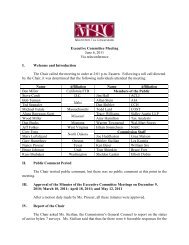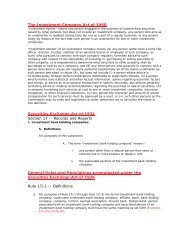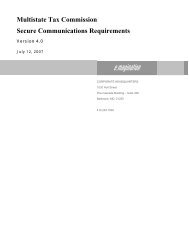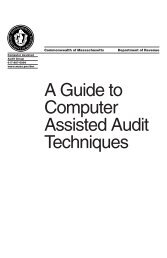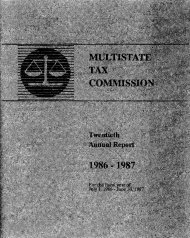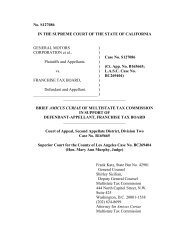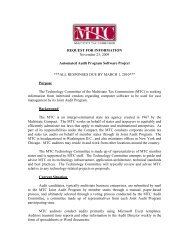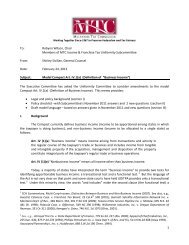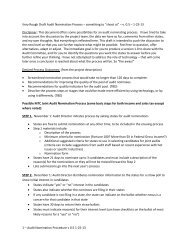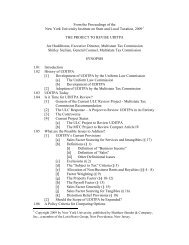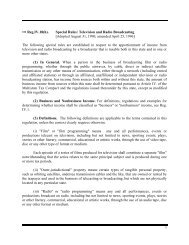Amendment to Model Regulation IV.17 - Multistate Tax Commission
Amendment to Model Regulation IV.17 - Multistate Tax Commission
Amendment to Model Regulation IV.17 - Multistate Tax Commission
Create successful ePaper yourself
Turn your PDF publications into a flip-book with our unique Google optimized e-Paper software.
Resolution Adopting an <strong>Amendment</strong> <strong>to</strong><br />
<strong>Multistate</strong> <strong>Tax</strong> <strong>Commission</strong> <strong>Regulation</strong> <strong>IV.17</strong><br />
Whereas, the purposes of the <strong>Multistate</strong> <strong>Tax</strong> <strong>Commission</strong> (<strong>Commission</strong>) pursuant <strong>to</strong> the<br />
<strong>Multistate</strong> <strong>Tax</strong> Compact are <strong>to</strong> “facilitate proper determination of State and local tax liability of<br />
multistate taxpayers, including the equitable apportionment of tax bases,” <strong>to</strong> “facilitate taxpayer<br />
convenience and compliance in the filing of tax returns,” and <strong>to</strong> “promote uniformity or compatibility<br />
in significant components of tax systems;” and<br />
Whereas, the <strong>Commission</strong> is charged with responsibility for developing model regulations<br />
<strong>to</strong> interpret the terms of the Compact (Art.VI.3(b) and Art.VII.1); and<br />
Whereas, in 1972, <strong>Model</strong> <strong>Regulation</strong> <strong>IV.17</strong> was adopted <strong>to</strong> interpret the terms “income<br />
producing activity” and “cost of performance;” and<br />
Whereas, the 1972 model regulation states that income producing activity “does not include<br />
the transactions and activities performed on behalf of a taxpayer, such as those conducted<br />
by independent contrac<strong>to</strong>rs;” and<br />
Whereas, the Uniformity Committee developed and referred <strong>to</strong> the Executive Committee<br />
an amendment <strong>to</strong> this 1972 model regulations which would eliminate that exclusion, the purpose<br />
of such amendment being <strong>to</strong> create a clear scope of application of the apportionment rule, reduce<br />
the potential for manipulation of the apportionment result, and ensure comportment with the<br />
statu<strong>to</strong>ry apportionment language; and<br />
Whereas, at the direction of the Executive Committee and pursuant <strong>to</strong> Art. VII of the<br />
<strong>Multistate</strong> <strong>Tax</strong> Compact, a public hearing was held Oc<strong>to</strong>ber 26, 2006 in Washing<strong>to</strong>n, D.C.; and<br />
Whereas, in November, 2006, the Hearing Officer filed a Report with the Executive<br />
Committee reflecting public comment received at the hearings and recommending changes <strong>to</strong><br />
the proposed amendment in light of the public comment; and<br />
Whereas, on November 14, 2006, the Executive Committee adopted the proposed Hearing<br />
Officer changes and recommended the proposed amendment <strong>to</strong> the <strong>Commission</strong>; and<br />
Whereas, pursuant <strong>to</strong> the authorization of the Executive Committee, on February 29,<br />
2007, the survey of the affected Member States required by Bylaw 7 of the <strong>Multistate</strong> <strong>Tax</strong> <strong>Commission</strong><br />
Bylaws was conducted; and
Whereas, a majority of the affected Member States indicated that they will consider<br />
adopting the proposed amendment if the <strong>Multistate</strong> <strong>Tax</strong> <strong>Commission</strong> recommends it as a uniformity<br />
proposal <strong>to</strong> the States; and<br />
Whereas, <strong>Commission</strong> finds that tax administra<strong>to</strong>rs and taxpayers alike would benefit<br />
from greater interstate uniformity, clarity and fairness by the adoption of the proposed amendment;<br />
and<br />
Whereas, the <strong>Commission</strong> finds the proposed amendment represents a conceptually<br />
sound and administrable uniformity measure;<br />
NOW THEREFORE, BE IT RESOLVED, that the proposed amendment <strong>to</strong> the commissions<br />
model regulations, as attached here<strong>to</strong> as Exhibit A, is hereby adopted as a uniformity<br />
recommendation of the <strong>Multistate</strong> <strong>Tax</strong> <strong>Commission</strong>.<br />
Adopted this 2 nd day of August 2007 by the <strong>Multistate</strong> <strong>Tax</strong> <strong>Commission</strong>.<br />
_____________________________<br />
Joan Wagnon, Chair<br />
______________________________<br />
Joe Huddles<strong>to</strong>n, Executive Direc<strong>to</strong>r<br />
2
<strong>Amendment</strong> <strong>to</strong> <strong>Model</strong> MTC <strong>Regulation</strong> <strong>IV.17</strong><br />
Regarding Treatment of Activities Performed “On Behalf Of” the <strong>Tax</strong>payer<br />
As approved by the <strong>Multistate</strong> <strong>Tax</strong> <strong>Commission</strong> August 2, 2007<br />
••• Reg. <strong>IV.17</strong>.<br />
Sales Fac<strong>to</strong>r: Sales Other Than Sales of Tangible Personal Property in<br />
This State<br />
(1) In general. Article <strong>IV.17</strong>. provides for the inclusion in the numera<strong>to</strong>r of the sales fac<strong>to</strong>r of<br />
gross receipts from transactions other than sales of tangible personal property (including transactions<br />
with the United States Government); under this section, gross receipts are attributed <strong>to</strong> this<br />
state if the income producing activity which gave rise <strong>to</strong> the receipts is performed wholly within<br />
this state. Also, gross receipts are attributed <strong>to</strong> this state if, with respect <strong>to</strong> a particular item of<br />
income, the income producing activity is performed within and without this state but the greater<br />
proportion of the income producing activity is performed in this state, based on costs of performance.<br />
(2) Income producing activity: defined. The term "income producing activity" applies <strong>to</strong> each<br />
separate item of income and means the transactions and activity directly engaged in by the taxpayer<br />
in the regular course of its trade or business for the ultimate purpose of producing that item<br />
of income obtaining gains or profit. Such activity does not includes transactions and activities<br />
performed on behalf of a taxpayer, such as those conducted on its behalf by an independent contrac<strong>to</strong>r.<br />
Accordingly, income producing activity includes but is not limited <strong>to</strong> the following:<br />
(A) The rendering of personal services by employees or by an agent or independent contrac<strong>to</strong>r<br />
acting on behalf of the taxpayer or the utilization of tangible and intangible property<br />
by the taxpayer or by an agent or independent contrac<strong>to</strong>r acting on behalf of the taxpayer<br />
in performing a service.<br />
(B) The sale, rental, leasing, licensing or other use of real property.<br />
(C) The rental, leasing, licensing or other use of tangible personal property.<br />
(D) The sale, licensing or other use of intangible personal property.<br />
The mere holding of intangible personal property is not, of itself, an income producing<br />
activity.<br />
(3) Cost of performance: defined. The term "costs of performance" means direct costs determined<br />
in a manner consistent with generally accepted accounting principles and in accordance<br />
with accepted conditions or practices in the trade or business of the taxpayer <strong>to</strong> perform the income<br />
producing activity which gives rise <strong>to</strong> the particular item of income. Included in the taxpayer's<br />
cost of performance are taxpayer’s payments <strong>to</strong> an agent or independent contrac<strong>to</strong>r for<br />
the performance of personal services and utilization of tangible and intangible property which<br />
give rise <strong>to</strong> the particular item of income.<br />
3
(4) Application.<br />
(A) In general. Receipts (other than from sales of tangible personal property) in respect<br />
<strong>to</strong> a particular income producing activity are in this state if:<br />
(a) the income producing activity is performed wholly within this state; or<br />
(b) the income producing activity is performed both in and outside this state and a<br />
greater proportion of the income producing activity is performed in this state than in any<br />
other state, based on costs of performance.<br />
(B) Special rules. The following are special rules for determining when receipts from the<br />
income producing activities described below are in this state:<br />
(a) Gross receipts from the sale, lease, rental or licensing of real property are in<br />
this state if the real property is located in this state.<br />
(b) Gross receipts from the rental, lease, or licensing of tangible personal property<br />
are in this state if the property is located in this state. The rental, lease, licensing or other<br />
use of tangible personal property in this state is a separate income producing activity<br />
from the rental, lease, licensing or other use of the same property while located in another<br />
state; consequently, if property is within and without this state during the rental, lease or<br />
licensing period, gross receipts attributable <strong>to</strong> this state shall be measured by the ratio<br />
which the time the property was physically present or was used in this state bears <strong>to</strong> the<br />
<strong>to</strong>tal time or use of the property everywhere during that period.<br />
Example: <strong>Tax</strong>payer is the owner of 10 railroad cars. During the year, the <strong>to</strong>tal of<br />
the days during which each railroad car was present in this state was 50 days. The<br />
receipts attributable <strong>to</strong> the use of each of the railroad cars in this state are a separate<br />
item of income and shall be determined as follows:<br />
(10 x 50) = 500 x Total Receipts = Receipts Attributable <strong>to</strong> this State<br />
3650<br />
(c) Gross receipts for the performance of personal services are attributable <strong>to</strong> this<br />
state <strong>to</strong> the extent that such services are performed in this state. If services relating <strong>to</strong> a<br />
single item of income are performed partly within and partly without this state, the gross<br />
receipts from the performance of such services shall be attributable <strong>to</strong> this state only if<br />
the greater proportion of the services was performed in the state, based on costs of performance.<br />
Usually, where services are performed partly within and partly without this<br />
state, the services performed in each state will constitute a separate income producing activity;<br />
in such cases, the gross receipts from the performance of services attributable <strong>to</strong><br />
this state shall be measured by the ratio which the time spent in performing the services<br />
in this state bears <strong>to</strong> the <strong>to</strong>tal time spent in performing the services everywhere. Time<br />
spent in performing services includes the amount of time expended in the performance of<br />
4
a contract or other obligation which gives rise <strong>to</strong> such gross receipts. Personal service not<br />
directly connected with the performance of the contract or other obligation, as for example<br />
time expended in negotiating the contract, is excluded from the computations.<br />
Example (i): <strong>Tax</strong>payer, a road show, gave theatrical performances at various locations<br />
in State X and in this state during the tax period. All gross receipts from performances<br />
given in this state are attributed <strong>to</strong> this state.<br />
Example (ii): The taxpayer, a public opinion survey corporation, conducted a poll<br />
by means of its employees in State X and in this state for the sum of $9,000. The<br />
project required 600 man-hours <strong>to</strong> obtain the basic data and prepare the survey<br />
report. Two hundred of the 600 man-hours were expended in this state. The receipts<br />
attributable <strong>to</strong> this state are $3,000.<br />
200 x $9,000 = $3,000<br />
600<br />
(C) Services on Behalf of <strong>Tax</strong>payer. An income producing activity performed on behalf<br />
of a taxpayer by an agent or independent contrac<strong>to</strong>r is attributed <strong>to</strong> this state if such income producing<br />
activity is in this state.<br />
(a) Such income producing activity is in this state:<br />
(i) when the taxpayer can reasonably determine at the time of filing that<br />
the income producing activity is actually performed in this state by the agent or<br />
independent contrac<strong>to</strong>r, but if the activity occurs in more than one state, the location<br />
where the income producing activity is actually performed shall be deemed <strong>to</strong><br />
be not reasonably determinable at the time of filing under (4)(C)(a)(i);<br />
(ii) if the taxpayer cannot reasonably determine at the time of filing where<br />
the income producing activity is actually performed, when the contract between<br />
the taxpayer and the agent or independent contrac<strong>to</strong>r indicates it is <strong>to</strong> be performed<br />
in this state and the portion of the taxpayer’s payment <strong>to</strong> the agent or contrac<strong>to</strong>r<br />
associated with such performance is determinable under the contract;<br />
(iii) if it cannot be determined where the income producing activity is actually<br />
performed and the agent or independent contrac<strong>to</strong>r's contract with the taxpayer<br />
does not indicate where it is <strong>to</strong> be performed, when the contract between<br />
the taxpayer and the taxpayer's cus<strong>to</strong>mer indicates it is <strong>to</strong> be performed in this<br />
state and the portion of the taxpayer’s payment <strong>to</strong> the agent or contrac<strong>to</strong>r associated<br />
with such performance is determinable under the contract; or<br />
(iv) if it cannot be determined where the income producing activity is actually<br />
performed and neither contract indicates where it is <strong>to</strong> be performed or the<br />
portion of the payment associated with such performance, when the domicile of<br />
the taxpayer’s cus<strong>to</strong>mer is in this state. If the taxpayer’s cus<strong>to</strong>mer is not an individual,<br />
“domicile” means commercial domicile.<br />
5
(b) If the location of the income producing activity by an agent or independent<br />
contrac<strong>to</strong>r, or the portion of the payment associated with such performance, cannot be determined<br />
under (4)(C)(a)(i) through (4)(C)(a)(iii), or the taxpayer’s cus<strong>to</strong>mer’s domicile<br />
cannot be determined under (4)(C)(a)(iv), or, although determinable, such income producing<br />
activity is in a state in which the taxpayer is not taxable, such income producing<br />
activity shall be disregard<br />
6



